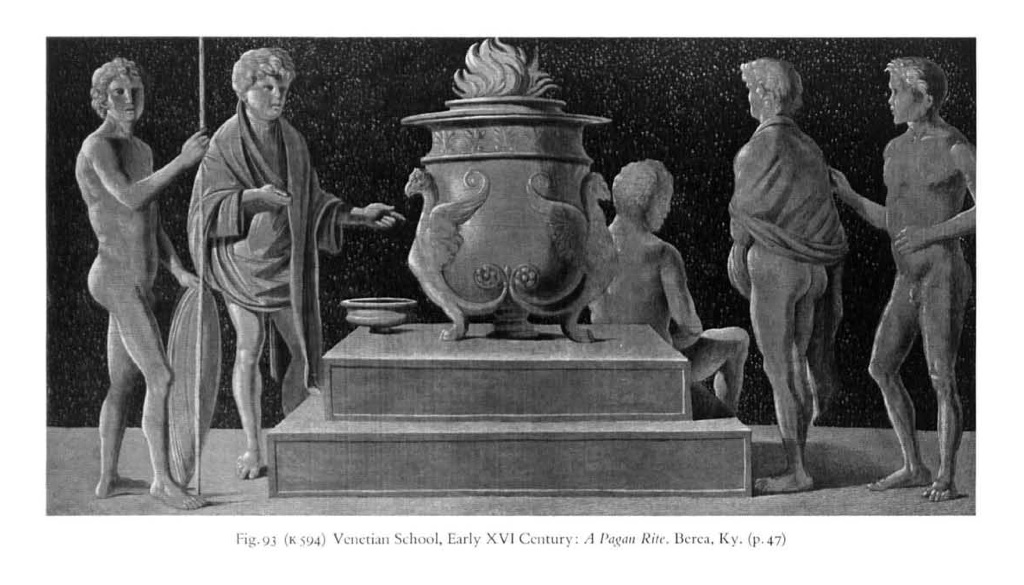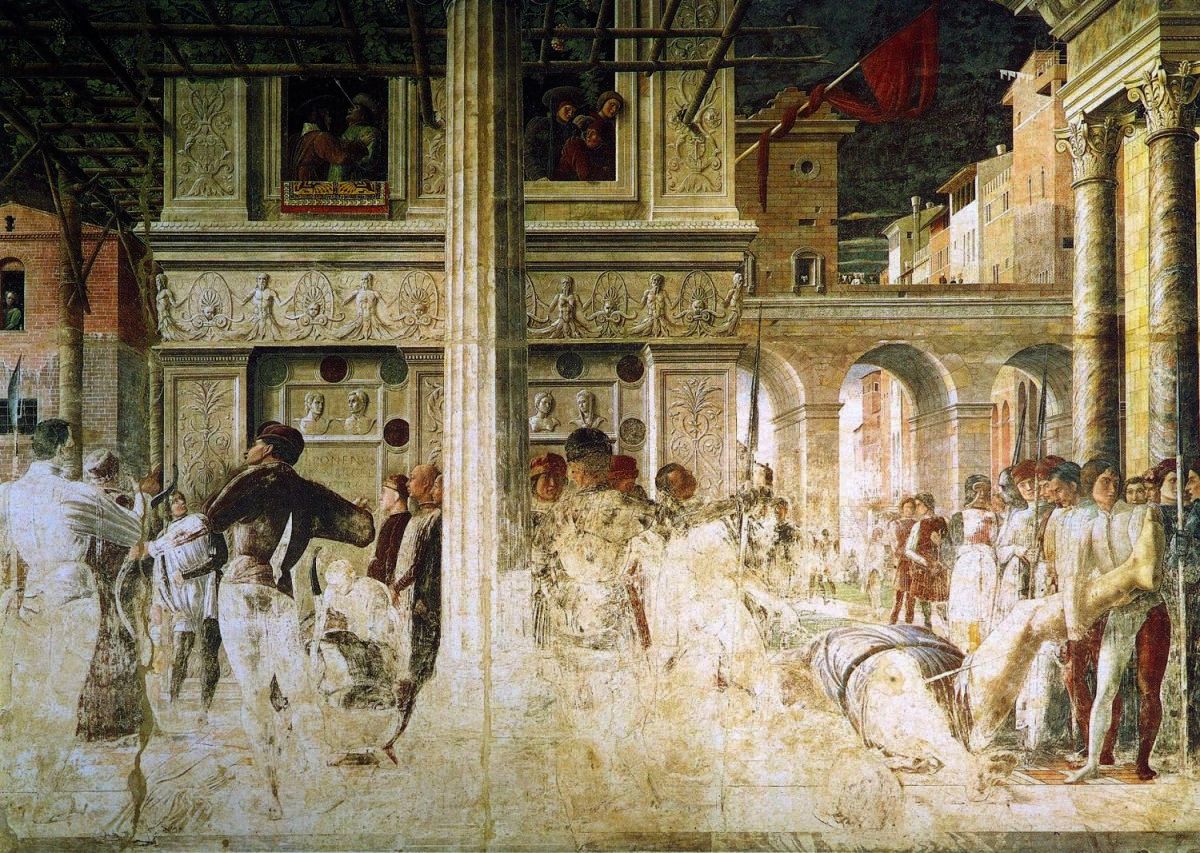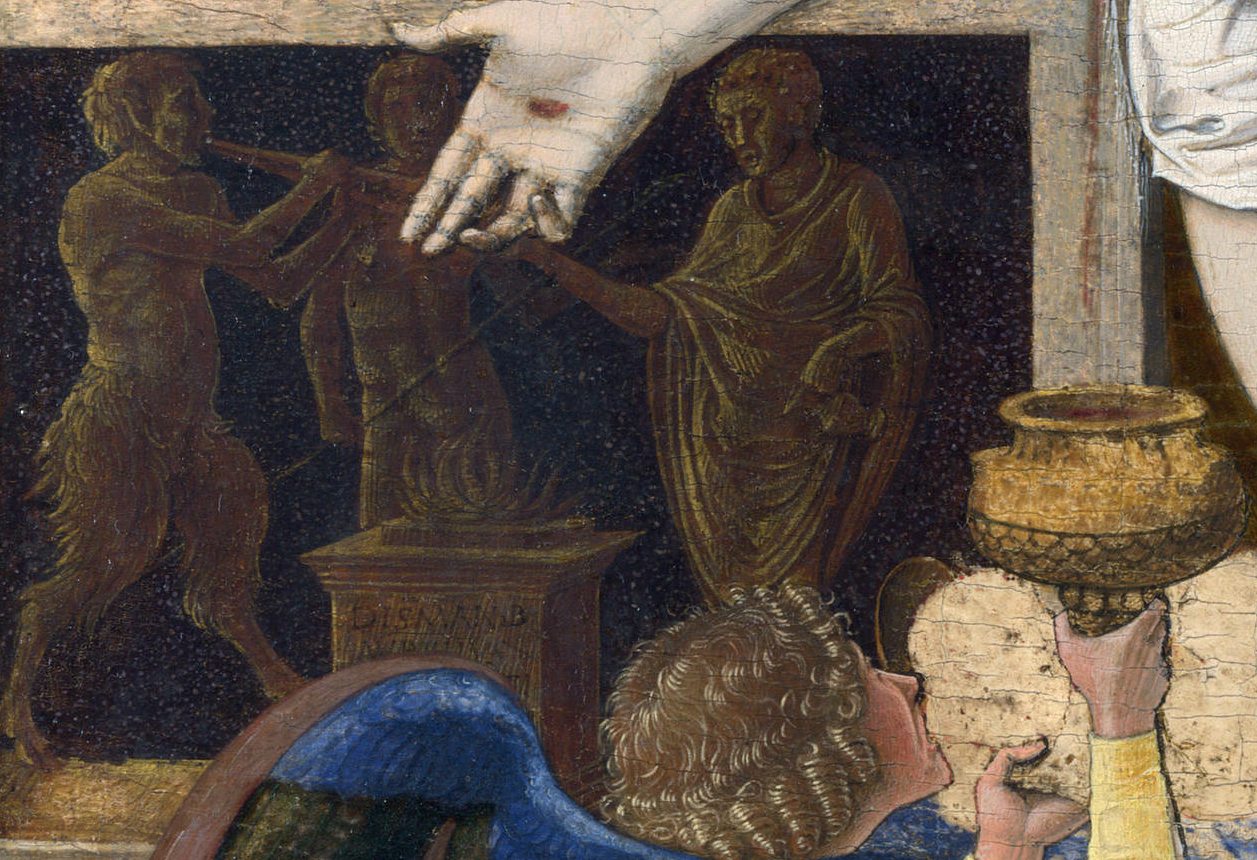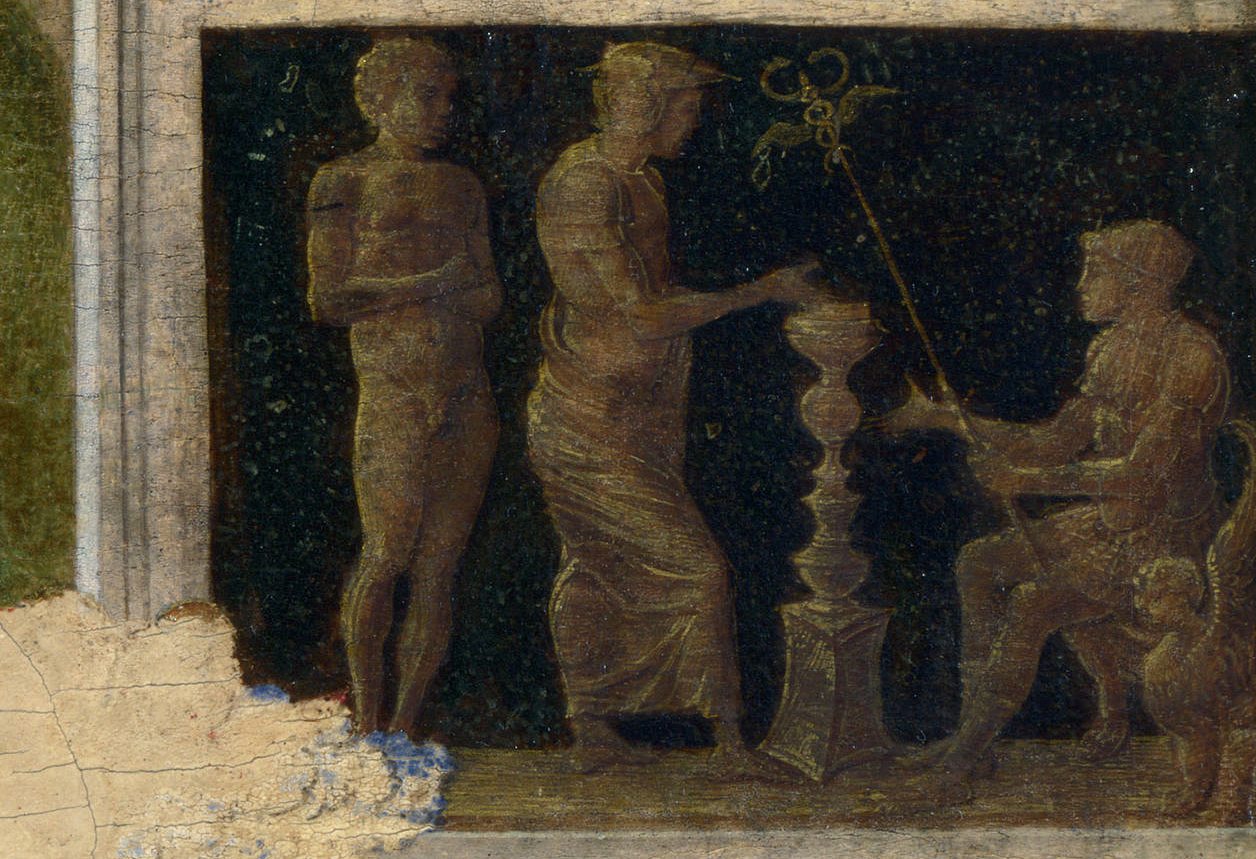M
I
C
R
O
S
T
O
R
Y
O
F
A
R
T
........................................................

NOW COMPLETED:

........................................................
MICROSTORY OF ART
ONLINE JOURNAL FOR ART, CONNOISSEURSHIP
AND CULTURAL JOURNALISM
........................................................
INDEX | PINBOARD | MICROSTORIES |
FEATURES | SPECIAL EDITIONS |
HISTORY AND THEORY OF ATTRIBUTION |
ETHNOGRAPHY OF CONNOISSEURSHIP |
SEARCH

........................................................



 >MICROSTORIES
>MICROSTORIES
- Richard Serra
- Martin Scorsese
- Claude Simon
- Sunshine
- Werner Herzog
- The Creation
- Marcel Duchamp
- Nino Rota
- Wölfflin and Woolf
- Hansjörg Schneider
- Kraftort Arkadien
- Visual Biography
- Schlaraffenleben
- Die Geisteswissenschaften
- The Voyeur
- Buzzword Sustainability
- Paul Verlaine
- Tao Yuanming
- New Beginning
- Seneca
- Still Lifes
- Charles Baudelaire
- Frédéric Chopin
- The Art History of Sustainability
- Wang Wei
- Solarpunk
- Historians of Light
- Lepanto
- Renaturalization
- Plates
- Snow in Provence
- Learning to See
- Picasso Dictionaries
- Peach Blossom Spring
- Picasso Tourism
- Tipping Points
- Sviatoslav Richter
- Weather Reports
- Treasure Hunt
- Another Snowscape in Picasso
- Picasso in 2023
- Dragon Veins
- The Gloomy Day
- The Art of the Pentimento
- Reforestation
- The Status of Painting
- Emergency Supply
- Punctuality
- Watching Traffic
- Zhong Kui
- How Painting Survived the 1990s
- Confirmation Bias
- Sustainability and Luxury
- Garage Bands
- Picasso and Artificial Intelligence
- Eyes of Tomorrow
- Picasso in 2023 2
- Gluing Oneself to Something
- Suburbia
- Bamboo
- Sustainability and Carpe Diem 1
- Interviews with Bruegel
- Sustainability and Carpe Diem 2
- Coffee & Sugar
- Bamboo 2
- Picasso in 2023 3
- Sustainability and Carpe Diem 3
- Cherry Orchard
- Old Magazines
- Chance
- Nick Drake
- Harlequin
- The Smartphone & the Art Book
- Atlas Syndrome
- The Kitchen
- Atlas Syndrome 2
- Consideration
- Tori Amos
- School
- Orchard Auctioning Day
- The Hundred Years’ War
- Sócrates
- Chameleon
- Nefertiti Bust
- Picasso as a Computer
- Sunflowers
- Philemon & Baucis
- Ode to the Radio
- Childhood
- Wimmelbild
- Restitution
- Nick Drake 2
- Wishful Thinking
- Sundays
- The Independent Scholar
- September
- The Fisherman by Pirosmani
- Microadventure
- Sociology
- Salvator Mundi
- Chillon
- Appassionata
- Amber
- Homer
- Berlin
- Planet Walk
- Improvisation
- Seeing Picasso
- These Nice Kids
- Robber
- The One
- The Sea Turtle
- Zoo
- Through the Hush
- Wunderkammer
- I Do Not Seek, I Find
- Shopping Mall
- Food Hamper
- The Secretary
- This Gate
- Nor Rainy Day
- House on a Hill
- Beautiful Island
- Second-hand Bookstore
- Flat
- Slap in the Face
- Serra, Wenkenpark
- Apologies
- The Bells
- Nordmann Fir
- Picasso Wanting To Be Poor
- Picasso, Pirosmani
- A Brief History of Sculpture
- 24 Sunsets
- Rusty Phoenix
- Glove
- Wintry Stanza
- A Song
- Like A Beatle
- Catching An Orange
- Solar Bees
- Permaculture

 >FEATURES
>FEATURES
- Van Gogh On Connoisseurship
- Two Museum’s Men
- Ende Pintrix and the City in Flames
- Titian, Leonardo and the Blue Hour
- The Man with the Golden Helmet: a documentation
- Un Jury d’admission à l’expertise
- Learning to See in Hitler’s Munich
- Leonardo da Vinci and Switzerland
- The Blue Hour Continued
- The Blue Hour in Louis Malle
- Kafka in the Blue Hour
- Blue Matisse
- Blue Hours of Hamburg and LA
- A Brief History of the Cranberry
- The Other Liberale in the House
- The Blue Hour in Raphael
- Who Did Invent the Blue Hour?
- Monet on Sustainability
- Velázquez and Sustainability
- The Blue Hour in Guillaume Apollinaire
- Van Gogh on Sustainability
- The Blue Hour in Marcel Proust
- Picasso and Sustainability
- The Contemporary Blue Hour
- The Blue Hour in 1492
- The Blue Hour in Hopper and Rothko
- Hopper and Sustainability
- The Blue Hour in Ecotopia
- The Hour Blue in Joan Mitchell
- Explaining the Twilight
- The Twilight of Thaw
- The Blue Hour in Pierre Bonnard
- Explaining the Twilight 2
- Picasso on Stalin
- Rubens on Sustainability
- The Salvator Mundi in Bruegel and Rubens
- The Blue Hour in Leonardo da Vinci and Poussin
- The Blue Hour in Rimbaud
- Faking the Dawn
- Frost and Thaw in Ilya Ehrenburg
- Picasso, Stalin, Beria
- Picasso, Solzhenitsyn and the Gulag
- Shostakovich on Picasso
- Hélène Parmelin in 1956
- Historians of Picasso Blue
- Picasso Travelling to Moscow 1
- The Blue Hour in Caravaggio
- Picasso Travelling to Moscow 2
- Picasso, the Knife Game and the Unsettling in Art
- Some Notes on Leonardo da Vinci and Slavery
- Picasso Moving to the Swiss Goldcoast
- The Blue Hour in Camus
- The Blue Hour in Symbolism and Surrealism
- Caspar David Friedrich in His Element
- Exhibiting the Northern Light
- Caspar David Friedrich in His Element 2
- Robert Schumann and the History of the Nocturne
- The Blue Hour in Robert Schumann
- Caspar David Friedrich and Sustainability
- The Twilight of Thaw 2
- Multicultural Twilight
- The Blue Hour in Anton Chekhov
- The Blue Hour in Medieval Art
- Twilight Photography
- The Blue Hour in Bob Dylan
- Iconography of Optimism

 >SPECIAL EDITIONS
>SPECIAL EDITIONS
- Visions of Cosmopolis
- Mona Lisa Landscapes
- Turner and Ruskin at Rheinfelden
- Painters On TV & On TV
- Spazzacamini in Art
- A Last Glance at Le Jardin de Daubigny
- The Experimental Cicerone
- A Dictionary of Imaginary Art Historical Works
- Iconography of Blogging
- Begegnung auf dem Münsterplatz
- Cecom
- Das Projekt Visual Apprenticeship
- Those Who See More
- A Fox on Seeing with the Heart
- Sammlung Werner Weisbach
- Daubigny Revisited
- Some Salvator Mundi Microstories
- Some Salvator Mundi Afterthougths
- Some Salvator Mundi Variations
- Some Salvator Mundi Revisions
- A Salvator Mundi Questionnaire
- A Salvator Mundi Puzzle
- Unknown Melzi
- Francis I and the Crown of Charlemagne
- From Amboise to Fontainebleau
- Drones Above Chambord
- Looking Back At Conques
- Flaubert At Fontainebleau
- Images of Imperial Ideology
- The Chronicles of Santa Maria delle Grazie
- Seeing Right Through Someone
- Melzi the Secretary
- Eying Glass
- A Foil to the Mona Lisa
- A Renaissance of the Cartoon
- Sketching a Family Tree
- Venetian Variations
- A Brief History of Digital Restoring
- A Consortium of Painters
- Leonardeschi and Landscape
- A Christ in Profile
- Learning to See in Spanish Milan
- A History of Gestures
- Leonardo and Josquin
- A Renaissance of the Hybrid
- Suida and Heydenreich
- The Watershed
- Three Veils
- From Beginning to End
- Connoisseurship of AI
- Twilight and Enlightenment
- The Blue Hour in Chinese Painting
- Dusk and Dawn at La Californie
- Iconography of Sustainability
- The Blue Hour in Goethe and Stendhal
- The Sky in Verlaine
- The Blue Hour in Paul Klee
- Iconography of Sustainability 2
- The Blue Hour in Charles Baudelaire
- From Bruegel to Solarpunk
- Some Salvator Mundi Documentaries
- Some More Salvator Mundi Monkey Business
- The Windsor Sleeve
- Brigitte Bardot’s Encounter with Picasso
- Art Historians and Historians
- A Salvator Mundi Chronicle
- The Salvator Mundi and the French Revolution
- The Fontainebleau Group
- The Encounter of Harry Truman with Pablo Picasso
- The Fontainebleau Group Continued
- The Windsor Sleeve Continued
- The Salvator Mundi in Early Netherlandish Painting 1
- Some Salvator Mundi Resources
- A New Salvator Mundi Questionnaire
- The Woman in Picasso
- The Yarborough Group
- Melzi, Figino and the Mona Lisa
- The Yarborough Group Continued
- A Salvator Mundi Global History
- The Salvator Mundi in Medieval Art
- The Salvator Mundi in Medieval Art 2
- The Salvator Mundi in Early Netherlandish Painting 2


 >HISTORY AND THEORY OF ATTRIBUTION
>HISTORY AND THEORY OF ATTRIBUTION
- The Mysterious »Donna Laura Minghetti-Leonardo«
- Assorted Demons of Connoisseurship
- Panofsky Meets Morelli
- Discovering the Eye of Sherlock Holmes
- Handling the Left-handed Hatchings Argument
- Visual History of Connoisseurship
- Alexander Perrig
- Connoisseurship in 2666
- What Postmodernity Has Done to Connoisseurship
- Dividing Four Fab Hands
- A Leonardesque Ambassador
- Test Cases in Connoisseurship
- A Raphael Expertise
- How to Tell Titian from Giorgione
- Louise Richter
- The Unique Property in the History of Connoisseurship
- An Expertise by Berenson
- The Book of Expertises
- An Album of Expertises
- An Expertise by Friedländer
- A Salvator Mundi Provenance
- How to Tell Leonardo from Luini
- An Expertise by Crowe and Cavalcaselle
- An Expertise by Bayersdorfer
- An Expertise by Hermann Voss
- An Expertise by Hofstede de Groot
- Leonardeschi Gold Rush
- An Unknown »Vermeer«
- An Expertise by Roberto Longhi
- An Expertise by Federico Zeri
- A Salvator Mundi Geography
- A Salvator Mundi Atlas
- The Bias of Superficiality
- 32 Ways of Looking at a Puzzle
- James Cahill versus Zhang Daqian
- Five Fallacies in Attribution
- On Why Art History Cannot Be Outsourced to Art Dealers
- On Why Artificial Intelligence Has No Place in Connoisseurship
- Salvator Mundi Scholarship in 2016
- Leonardo da Vinci at the Courts
- The Story of the Lost Axe
- The Last Bruegel
- A Titian Questionnaire
- On Where and Why the Salvator Mundi Authentication Did Fail
- The Problem of Deattribution

 >ETHNOGRAPHY OF CONNOISSEURSHIP
>ETHNOGRAPHY OF CONNOISSEURSHIP
MICROSTORY OF ART
ONLINE JOURNAL FOR ART, CONNOISSEURSHIP
AND CULTURAL JOURNALISM
........................................................

***
ARCHIVE AND FURTHER PROJECTS

1) PRINT


***
2) E-PRODUCTIONS


........................................................

........................................................

........................................................
FORTHCOMING:


***
3) VARIA

........................................................

........................................................

........................................................

........................................................

........................................................
***
THE GIOVANNI MORELLI MONOGRAPH

- The Giovanni Morelli Monograph
........................................................
MICROSTORY OF ART
ONLINE JOURNAL FOR ART, CONNOISSEURSHIP AND CULTURAL JOURNALISM
HOME
An Expertise by Roberto Longhi
The Virtual Museum
of Art Expertise –
An Expertise by
Roberto Longhi
Roberto Longhi (1890-1970)

An Expertise by Roberto Longhi
How to read, to assess, to interpret an expertise? – What we are suggesting here is a system for which I am claiming a copyright. Not for the expertise itself, of course, which is by as legendary a connoisseur/art historian as Roberto Longhi. But for our scroll system, which allows to visualize all visual comparisons within this, within every expertise.
May we say that it does reveal all the comparisons? Since, once again, by making something transparent, we actually work against the power of an expert, since the plausibility of every visual clue can be scrutinized here. Which would not be possible if we only would be able to read this expertise.
 (Picture: pasolinipuntonet.blogspot.com; background picture: DS) Welcome to the Sala Longhi |
 (Source: Fern Rusk Shapley, Paintings from the Samuel H. Kress Collection (Italian Schools, XV-XVI century), 1968; bg picture: galleryhip.com) Thank you, visitor, for visiting the Sala Longhi of our Museum of Expertises (›I see you have The Eye, I too have The Eye, we shall be friends‹, as the old gentleman once said to Sotheby’s expert Bruce Chatwin). And now: let us walk through an expertise by Italian connoisseur Roberto Longhi. By which I mean: We shall walk now through a ›Pagan Rite‹, a visualization of what Roberto Longhi once wrote, about a not at all prominent picture. And I am working hard to get all the reference material together that Longhi then referred to. With or without the reader of his expertise then having it, but this doesn’t bother us, since technology has moved on, and we are now able to treat words as architecture that is going to take on a particular shape: the shape of the virtual Sala Longhi. But virtual or not, I hope that we are going to see something. |
 »The chiaroscuro that I recently discovered in a Milanese collection (…) is painted in gradations of sepia with highlights of white lead, and this quasi monochromatic treatment, in addition to the remarkable thickness of the panel (…) leads me to think that what we have here is a fragment of the old decoration of a ›cassone‹ or a ›restello‹.« Here the narrator has to interfere for the first time, I am afraid, to say a couple of things: First of all: we are quoting Longhi after Elisabetta Landi, The Antiquarian Carlo Alberto Foresti of Carpi, a Correspondent of Bernard Berenson, in: Joseph Connors and Louis A. Waldman (Ed.), Bernard Berenson. Formation and Heritage, 2014, p. 325f. The author, Elisabetta Landi, is a granddaughter of Carlo Alberto Foresti, and the »Milanese collection« that Longhi is referring to is of course the collection (or the studio) of Carlo Alberto Foresti. It might be also, or it might not be mentioned that others had known the painting in question before Longhi ›discovered‹ it. Discovering it, thus, means here: he, Longhi, did not know the painting before (but others did). Last but not least: I hope that we won’t have many interruptions of this kind, but in the very moment that I am writing this, I have absolutely no clue what the results of our exploration into this Longhi expertise will be. Another digression (I am so sorry): Longhi had expressed his opinion as to the painting in a letter to Foresti before he was writing the review, that was published in 1927, from which we are (indirectly) quoting. And while, in the letter, Longhi referred to the painting as »a work close to Giovanni Bellini, even if not (…) entirely his (…)«, the published review, opinion or expertise does give the painting to Giovanni Bellini. And if we are saying this right now, we are in some sense revealing who the murderer was, but only in some sense, because only if we consider Longhi as the only Sherlock Holmes. But actually, and this I know already and in this very minute that I am writing: we are going to finish our review with a list of differing opinions of who the murderer might have been. Now we may proceed. |
(Picture: Sailko) And thanks to Sailko (Francesco Bini), the indefatigable photographer, the unknown donor (it is incredible what you do), we have: a cassone (thank you, Sailko). The term ›restello‹, by the way, refers to a piece of Renaissance furniture to be found in toilet rooms, especially in Venice (see for example: Costanza Caraffa/Almut Goldhahn, Fotografien als Forschungsobjekte – Der Nachlass Gustav Ludwigs in der Photothek des Kunsthistorischen Instituts in Florenz, in: Irene Ziehe et al. (Ed.), Fotografie und Film im Archiv: Sammeln, Bewahren, Erforschen, 2013; the German art historian Gustav Ludwig was, among other things, the specialist for Renaissance Venice household inventories). |
 And back to our Longhi expertise (bg picture: Sailko) |
 »To the sides of an altar, or rather of the stepped pedestal of a flaming tripod, are four figures arranged in couples; to the left a warrior armed with a spear and shield, next to him a very ungainly old man (pappo) (…) at right two fauns or sylvans (…) while a fifth figure, a rustic type (…) sits behind the tripod with his back turned to it, on the lowest step of the marble pedestal. The scene is set against a brown background, as though feigned marmo mischio. There is no doubt that the artist of this painting defers, at least iconographically, to Mantegna: the illusionistic reliefs in the architecture of the Eremitani are the precedents (…). But in making the comparison with Mantegna one cannot go beyond this generic observation (…). Look at the delicate reliefs, treated almost as if they were monochrome paintings, in the parapet of the scene of The Blood of the Redeemer in London. And now look at the panel [our picture in question; DS], likewise of an obscure antique subject, which was formerly in the Stroganoff collection under the name of the Ferrarese de Roberti (…). And then we have (…) from around 1475, those combatants, on foot and on horseback (…) in the relief decorating the upper part of the throne in the Pesaro altarpiece. The figures on the right already appear substantial enough to presage the manner of the San Giobbe altarpiece; in particular, the faun in profile on the right already alludes to the form of St. Sebastian in the Uffizi Allegory; at the same time the draperies of the sylvan on the left (…) are handled in a way that recalls the Madonna of Bergamo (Lochis), and his hair, like that of the warrior, with curls that almost appear drawn with the sculptor’s tool rather than that of a painter, is the same as the hair of the putti in the Madonna dell’Orto, or in the similar work in Berlin. And wholly in the spirit of the young Giovanni, son and assistant of Jacopo, is the figure of the warrior, so slender and angular (…) as not to displease Dürer (…) [and] which could be inscribed, roughly, in a starfish, like those gothic men of Villard de Honnecourt. All this leads us to conclude, therefore (…) that this work was painted by Bellini shortly after the Pesaro altarpiece (…) the five-year period 1475-1480 seems to us to offer a general time frame for the probable date of this Milanese chiaroscuro.« |
 »And then we have (…)«, Longhi is saying once. And I am afraid that the narrator has to step in also subsequently, but I am getting a bit upset as I am feeling that a lot of things we actually have not. First of all: in our city we have no copy of the journal in which this text by Longhi was originally published. So I have no inkling for the moment, if this text was, originally, illustrated at all. Secondly: if I can spare time I am going to check what Longhi says in the many passages that Elisabetta Landi did leave out, since I am assuming that this text is also to be found within the edition of works by Longhi (that we have; and I am also curious if this text might have illustrations with it). Because, frankly, I have to admit that while merely reading Longhi’s words (and while copying these words), I am feeling that I have not stored all the details he mentions in my visual memory, and I am saying this, of course, before I am going now to get all these details, in case I can. And speaking of pictures and illustrations, one might also mention that Longhi mentions London, Berlin, Milan and implicitly other places in Italy, where the originals he is referring to are actually to be found (if not damaged in war times or, as in one case, stolen). Not to mention the original of the painting in question (it’s in the United States) of which we have, fortunately, a picture, a black and white picture, but not a picture that I am actually thrilled of (zooming into the hair might result in finding pixel nits of rustic type). |
 Reference Material I: a generic comparison with Mantegna   (as to war damages and to attempts of virtual or actual reconstruction see here) |
 Reference Material II: focussing on Mantegna-influenced young Giovanni Bellini  The Blood of the Redeemer in London (picture: pinterest.com)     »…the relief decorating the upper part of the throne in the Pesaro altarpiece«  (Picture: cbccoop.it) (as for the Pesaro altarpiece see also here) |
 Reference Material III: elaborating the comparison  »…to presage the manner of the San Giobbe altarpiece«   »…the faun in profile on the right already alludes to the form of St. Sebastian in the Uffizi Allegory«   »…the draperies of the sylvan on the left (…) are handled in a way that recalls the Madonna of Bergamo (Lochis)«   »…and his hair, like that of the warrior, with curls that almost appear drawn with the sculptor’s tool rather than that of a painter, is the same as the hair of the putti in the Madonna dell’Orto, or in the similar work in Berlin« |
 A Sideglance to Dürer and Villard de Honnecourt  (Picture: dickduenn.de)   (Picture: Lokilech) |
 Finally: a list of those who did not (exactly) agree Elisabetta Landi is writing that Bernard Berenson did not agree with Longhi’s attribution (and classified the painting in question as a »study«, which probably means: by an Anonymous, and probably after Bellini or after Mantegna, this is not quite clear). But ›not agreeing‹ is also a relative notion here: The painting had been given to Ercole de’ Roberti, then to ›School of Mantegna‹ (by Paul Kristeller), then Longhi came; and after Longhi there was Mason Perkins agreeing with Longhi, and then Berenson. Then came Fritz Heinemann preferring ›Anonymous Painter, working in the style of Bellini‹, upon which Fern Rusk Shapley named the painting as ›Venetian School‹ (two namings that have a somewhat diplomatic ringing as they not actually wanted to disagree with Longhi or Berenson, or at least not openly or too much). And the list could probably be continued and updated. But this is the moment for a personal judgment. My personal judgment, not as to the attribution, but as to what I have been preparing here, is that I have learnt a lot. That I am learning a lot. I am happy that I’ve found a principle to assemble the reference material as a sort of scroll (and we sing a praise to the magic mouse), with the painting in question appearing again and again in between. To comprehend the axes of Longhi’s comparisons a slight movement of the index fingertip is actually enough. Who would have foreseen that (and who would have foreseen a starfish to appear)? Frankly: I dont’t know if the painting in question was made by young Giovanni Bellini, and frankly: I can live with IF and THEN. Which means: if you accept a premise, the one or other axis of the system of comparisons might be convincing, or more or less be convincing. It is a system of hypothetical constructions. We work with possibilities, probabilities, relative certainties here, and also frankly (and somewhat provocatively): Is it not more interesting to have more possibilities, more perspectives? This might be the philosophy of a sceptical observer of connoisseurship who is more interested in learning what results from the process of attribution and less in the actual results, and not that of someone who actually does practice attributing, but it is also the philosophy of someone who does like learning in general and who does like to see something with someone else’s eyes. A lot of different opinions might be a horror for someone seeking certainty. I am not seeking certainty, at least not in this case and here, but I am seeking interesting perspectives to make the perception of art more interesting, and connoisseurship something that actually does not empoison life, but, as Berenson had it (with Nietzsche), as something to enhance life, and ideally for everyone who likes this too.  (Picture: Lokilech) |
 (Picture: pasolinipuntonet.blogspot.com; background picture: DS) Thank you for visiting the Sala Longhi |
MICROSTORY OF ART
ONLINE JOURNAL FOR ART, CONNOISSEURSHIP AND CULTURAL JOURNALISM
HOME
© DS